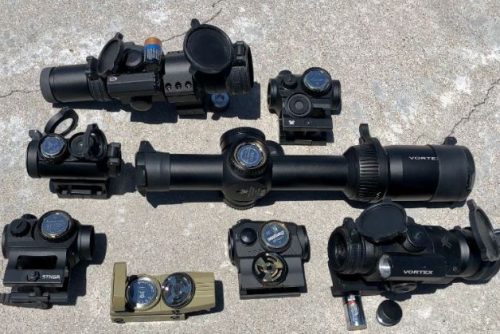As the optics world continues to advance, investing in the right optic for your firearm can significantly impact your shooting experience, whether it is for competition shooting, hunting, or training for personal defense. Choosing between an LPVO vs red dot sight is largely a matter of individual preference as the two are popular choices among shooters today.
Each optic offers distinct advantages tailored to different shooting scenarios and preferences. It is therefore important to understand the strengths and applications of each to determine which optic best suits your needs.
In this guide, we delve into the considerations between LPVOs and Red Dot Sights, show you the pros and cons of each and help you make an informed decision on which optic will optimize your shooting performance.
Let’s start by understanding each optic in detail.
What is an LPVO?
An LPVO is a Low Power Variable Optic designed for close, medium, and long-range shooting applications. Generally, LVPOs are designed to offer a variable magnification range starting from a true 1x (or near 1x) up to higher magnifications, typically around 4x to 10x. This makes them versatile for most shooting applications at close-quarters and medium-range engagements.
Specifications
Magnification Range
The common magnification ranges of LPVOs are 1-4x, 1-6x, 1-8x, 1-10x.The true 1x allows for quick target acquisition with both eyes open, similar to a red dot sight. When you ramp up the magnification to the highest settings, you can use the LPVO to acquire targets at extended distances.
Objective Lens Diameter
The objective diameter of LPVOs usually ranges between 20mm to 34mm. The size affects light transmission and field of view with larger diameters being the best for use in low light settings.
Reticle Type
LPVOs have different reticles housed in either the first or second focal plane. Often these scopes feature BDC (Bullet Drop Compensation) or mil-dot reticles. Furthermore, most LPVOs have illuminated reticles just like red dot sights to ensure precision aiming in low light settings.
Tube Diameter
The common tube diameters of LPVOs are 30mm or 34mm. The larger the tube is, the more space it provides for adjustments and reticle movement. Furthermore, a large tube diameter offers better light transmission for bright and crisp image views.
Adjustment Turrets
LPVO scopes just like traditional rifle scopes feature windage and elevation adjustments. Additionally, they often feature capped turrets to prevent accidental changes.
Eye Relief
Eye relief is the distance between the eye and the scopes objective lens. It varies from one LPVO to the other and typically ranges from 3.5 to 4 inches. A long eye relief in an LPVO is important for maintaining a clear sight picture without risk of scope bite.
Field of View (FOV)
Field of view refers to the total area one can see through a scope without moving it around. It varies by magnification and design. A large field of view is important for situational awareness, especially at 1x. It also aids in quick target identification and acquisition.
Pros of LPVOs
1.Versatility
LPVOs are suitable for a wide range of engagements from close quarters to medium range. Most LPVOs combine the benefits of a red dot and a magnified optic for use in various shooting applications.
2. Quick Target Acquisition
The true 1x magnification allows for rapid target engagement with both eyes open. Additionally, it makes the LPVO ideal for dynamic and fast-paced shooting scenarios.
3. Enhanced Precision
The higher magnification in LPVOs allows for better precision at extended ranges. It also makes the optic useful for hunting, tactical applications, and competition shooting.
4. Durability
In LPVOs vs red dot sights, durability is a feature that stands out in both. These optics are designed to withstand harsh conditions and recoil. Furthermore, they are typically waterproof, fog proof, and shockproof for all weather operability.
5. Illuminated Reticles
Most LPVOs have illuminated reticles that improve visibility in low light conditions. The reticle illumination also allows for quick target acquisition even in dim environments.
Cons of LPVOs
1. Weight and Size
LPVOs are generally heavier and bulkier than red dot sights or fixed power scopes. The bulkiness can affect the balance and handling of the rifle.
2. Cost
High-quality LPVOs are expensive and often require additional investment in robust mounts.
3. Complexity
To use an LPVO, you requires familiarity with variable magnification and reticle sub tensions. Models with more complex reticles are more difficult to use than simple red dot sights or fixed magnification scopes.
Popular LPVO Models:
1. Vortex Razor HD Gen III 1-10×24
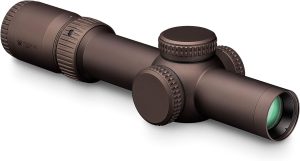
- Magnification: 1-10x
- Objective Lens Diameter: 24mm
- Tube Diameter: 34mm
- Reticle: FFP, illuminated
- Weight: 21.5 oz
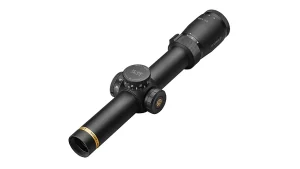
- Magnification: 1-6x
- Objective Lens Diameter: 24mm
- Tube Diameter: 30mm
- Reticle: FFP or SFP, illuminated
- Weight: 13.4 oz

- Magnification: 1-8x
- Objective Lens Diameter: 24mm
- Tube Diameter: 30mm
- Reticle: SFP, illuminated
- Weight: 16.9 oz
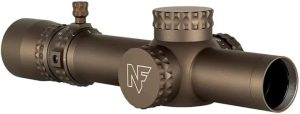
- Magnification: 1-8x
- Objective Lens Diameter: 24mm
- Tube Diameter: 30mm
- Reticle: FFP or SFP, illuminated
- Weight: 17 oz
What is a Red Dot Sight?
A red dot sight is a type of non-magnifying reflector sight used for aiming in firearms. It provides a point of aim in the form of an illuminated red dot which simplifies aiming and aids in speedy target acquisition and precision shooting. Red dot sights are popular for their speed, accuracy, and ease of use, especially in dynamic shooting scenarios.
Specifications
Reticle
The reticle is the red dot that the user sees. The size of the red dot varies from one product to the other and the common sizes are 2 MOA, 3 MOA, 4 MOA, and 6 MOA.
Small reticles of 3 MOA and below are and more precise and the best for shooting applications where speedy and accurate target acquisition is vital. On the other hand, larger reticles of 4 MOA and 6 MOA are quicker to acquire and most ideal for beginners and individuals with aging eyes.
Lens Coatings
Red dot sights have anti-reflective coatings on the lens to help in reducing glare and enhancing light transmission.
Battery Life
Most red dot sights are powered by batteries. Depending on the model, battery life can range from hundreds to tens of thousands of hours. Advanced models may have features like auto shut-off to conserve battery.
Brightness Settings
The red dot reticle features adjustable brightness settings, crucial for visibility in various lighting conditions, from bright daylight to low light or night settings.
Parallax-Free
In LPVOs vs red dot sights, red dot sights are typically parallax-free. This means the dot remains on target even if the shooter’s head or eye position shifts.
Durability
Durability is another attribute associated with most red dot sights. They feature robust construction to withstand recoil, shock, and environmental factors like water and dust. Many are also rated as waterproof or water-resistant.
Mounting Options
Moreover, most red dot sights are built with multifunctionality in mind. They are compatible with various mounting systems like Picatinny, Weaver rails. Besides, these optics are compatible with different firearm from handguns to shotguns to rifles.
Pros of Red Dot Sights
1. Speed
The simplified point of aim in red dot sights allows for rapid target acquisition since the shooter only needs to align the dot with the target, without worrying about aligning front and rear sights.
2. Large Field of View
With 1x magnification, red dot sights provide an unlimited field of view, making them ideal for close-quarters and dynamic shooting situations in LPVO vs red dot sight.
3. Ease of Use
Furthermore, red dot sights are built with ease of use in mind. They are generally simpler to use, even for beginners in shooting.
4. Versatility
Versatility is another feature that sets apart LPVO vs red dot sight. Red dot sights are suitable for a variety of firearms, including handguns, rifles, and shotguns. Some models can also be used on crossbows or even cameras.
5. Accuracy
While not magnified, red dot sights can still improve accuracy, especially at short to medium ranges.
6. Durability
Red dot sights are built with hard-wearing materials and shockproof shields to withstand harsh conditions and heavy use. Many are also shockproof and waterproof.
Cons of Red Dot Sights
1. Battery Dependence
Most red dot sights depend on batteries, and if the battery fails, the sight becomes inoperable. However, this can be mitigated by using models with long battery life and keeping spare batteries.
2. Limited Range
Red dot sights are best suited for short to medium ranges. They are not ideal for long-range precision shooting.
3. Lens Reflection
In certain lighting conditions, the lens can produce glare or reflections, although good lens coatings can minimize this.
4. Training:
While most red dot sights are easy to use, transitioning from traditional iron sights to red dot sights may require some initial training and practice.
Popular Red Dot Sights Models
1. Trijicon MRO (Miniature Rifle Optic)
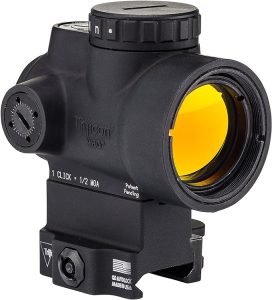
- Wide field of view
- Durable construction
- Long battery life
- Crisp 2 MOA dot.
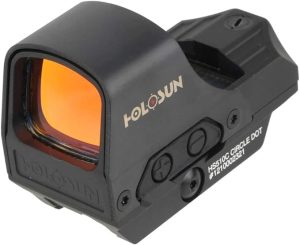
- Solar backup
- Multiple reticle system
- Long battery life
- Durable construction
- Versatile and reliable
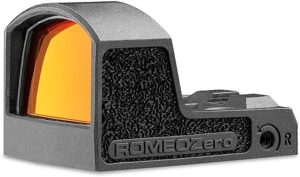
- Affordable
- 2 MOA dot
- 40,000 hours of battery life
- MOTAC (Motion Activated Illumination)

- Lightweight
- Waterproof construction
- Versatile
- Ease of use
Read Also
Final Thoughts
In conclusion, the choice between LPVO vs red dot sight is largely a matter of individual preference. Red dot sights are a valuable sighting tool for many shooting applications, offering speed, ease of use, and improved accuracy at short to medium ranges. LPVOs on the other hand, are an excellent choice for shooters needing flexibility across a range of shooting scenarios. Determine your preferences and choose the optic that blend best with your needs.

